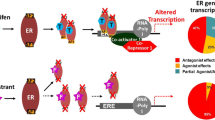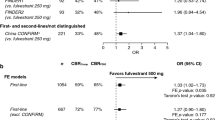Abstract
-
▴ Fulvestrant is a 7α-alkylsulphinyl analogue of estradiol that competes with endogenous estrogen for binding to the estrogen receptor. Once bound to the receptor, fulvestrant attenuates receptor dimerisation, effecting a rapid degradation of the estrogen receptor protein and inhibition of transcription.
-
▴ Fulvestrant is a potent inhibitor of the growth of human breast cancer cells in vitro and in vivo. It has demonstrated pure anti-estrogenic activity in animal systems.
-
▴ Intramuscular fulvestrant 250mg once a month was as effective as the oral aromatase inhibitor anastrozole 1 mg/day in 2 phase III trials in post-menopausal women with advanced breast cancer who had received prior endocrine therapy.
-
▴ Median time to disease progression (the primary end-point) with fulvestrant and anastrozole was 5.4 and 3.4 months (North American trial) and 5.5 and 5.1 months (European trial). The median duration of response was 19.3 and 10.5 months (North American trial) and 14.3 and 14.0 months (European trial).
-
▴ The most common adverse events with fulvestrant are gastrointestinal disturbances and hot flushes. Fulvestrant showed similar tolerability to anastrozole in 2 phase III trials.


Similar content being viewed by others
References
Wakeling AE, Dukes M, Bowler J. A potent specific pure anti-estrogen with clinical potential. Cancer Res 1991; 51(15): 3867–73
Wakeling AE, Bowler J. Steroidal pure antioestrogens. J Endocrinol 1987; 112:R7–R10
Parker MG. Action of ‘pure’ antiestrogens inhibiting estrogen receptor action. Breast Cancer Res Treat 1993; 26: 131–7
Fawell SE, White R, Hoare S, et al. Inhibition of estrogen receptor-DNA binding by the ‘pure’ antiestrogen ICI 164,384 appears to be mediated by impaired receptor dimerization. Proc Natl Sci USA 1990; 87: 6883–7
Gibson MK, Nemmers LA, Beckman WC, et al. The mechanism of ICI 164384 antiestrogenicity involves rapid loss of estrogen receptor in uterine tissue. Endocrinology 1991; 129: 2000–10
Dauvois S, Danielian PS, White R, et al. Antiestrogenic ICI 164,384 reduces cellular estrogen receptor content by increasing its turnover. Proc Natl Acad Sci USA 1992; 89: 4037–41
Dauvois S, White R, Parker MG. The antiestrogen ICI 182780 disrupts estrogen receptor nucleocytoplasmic shuttling. J Cell Sci 1993 Dec; 106: 1377–88
de Cupis A, Noonan D, Pirani P, et al. Comparison between novel steroid-like and conventional nonsteroidal antioestrogens in inhibiting oestradiol- and IGF-I-induced proliferation of human breast cancer-derived cells. Br J Pharmacol 1995 Nov; 116:2391–400
Lykkesfeldt AE, Madsen MW, Briand P. Altered expression of estrogen-regulated genes in a tamoxifen-resistant and ICI 164,384 and ICI 182,780 sensitive human breast cancer cell line, MCF-7/TAMR-1K Cancer Res 1994 Mar 15; 54: 1587–95
Coradini D, Biffi A, Cappelletti V, et al. Activity of tamoxifen and new antiestrogens on estrogen receptor positive and negative breast cancer cells. Anticancer Res 1994; 14: 1059–64
Lykkesfeldt AE, Larsen SS, Briand P. Human breast cancer cell lines resistant to pure anti-estrogens are sensitive to tamoxifen treatment. Int J Cancer 1995 May 16; 61: 529–34
Osborne CK, Coronado-Heinsohn EB, Hilsenbeck SG, et al. Comparison of the effects of apure steroidal antiestrogen with those of tamoxifen in a model of human breast cancer. J Natl Cancer Inst 1995; 87: 746–50
Hu XF, Veroni M, De Luise M, et al. Circumvention of tamoxifen resistance by the pure anti-estrogen ICI 182, 780. Int J Cancer 1993; 55: 873–6
Osborne CK, Jarman M, McCague R, et al. The importance of tamoxifen metabolism in tamoxifen-stimulated breast tumor growth. Cancer Chemother Pharmacol 1994; 34: 89–95
DeFriend DJ, Anderson E, Bell J, et al. Effects of 4-hydroxytamoxifen and a novel pure antioestrogen (ICI 182780) on the clonogenic growth of human breast cancer cells in vitro. Br J Cancer 1994; 70: 204–11
Huynh H, Nickerson T, Pollak M, et al. Regulation of insulinlike growth factor I receptor expression by the pure antiestrogen ICI 182780. Clin Cancer Res 1996; 2: 2037–42
Long BJ, Tilghman SL, Yue W, et al. The steroidal antiestrogen ICI 182,780 is an inhibitor of cellular aromatase activity. J Steroid Biochem Mol Biol 1998; 67: 293–304
Dukes M, Waterton JC, Wakeling AE. Antiuterotrophic effects of the pure antioestrogen ICI 182,780 in adult female monkeys (Macaca nemestrina): quantitative magnetic resonance imaging. J Endocrinol 1993; 138: 203–10
Gallagher A, Chambers TJ, Tobias JH. The estrogen antagonist ICI 182,780 reduces cancellous bone volume in female rats. Endocrinology 1993; 133: 2787–91
Sato K, Nohtomi K, Shizume K, et al. 17 β-estradiol increases calcium content in fetal mouse parietal bones cultured in serum-free medium only at physiological concentrations. Bone 1996; 19(3): 213–21
Wakeling AE. The future of new pure antiestrogens in clinical breast cancer. Breast Cancer Res Treat 1993; 25: 1–9
DeFriend DJ, Howell A, Nicholson RI, et al. Investigation of a new pure antiestrogen (ICI 182780) in women with primary breast cancer. Cancer Res 1994; 54: 408–14
Dixon JM, Nicholson RI, Robertson JFR, et al. Comparison of the short-term biological effects of fulvestrant (ICI 182,780) with tamoxifen in postmenopausal women with primary breast cancer [abstract no. 161]. Eur J Cancer 2000; 36 Suppl. 5:S73
Howell A, DeFriend DJ, Robertson JF, et al. Pharmacokinetics, pharmacological and anti-tumour effects of the specific antioestrogen ICI 182780 in women with advanced breast cancer. Br J Cancer 1996; 74: 300–8
Thomas EJ, Walton PL, Thomas NM, et al. The effects of ICI 182,780, a pure anti-oestrogen, on the hypothalamic-pituitarygonadal axis and on endometrial proliferation in pre-menopausal women. Hum Reprod 1994; 9: 1991–6
Robertson JFR. A comparison of the single-dose pharmacokinetics of ‘Faslodex’ (fulvestrant) 250 mg when given as either a one x 5-ml intra-muscular injection or two × 2.5-ml injections in postmenopausal women with advanced breast cancer [abstract no. 172]. Breast Cancer Res Treat 2000; 64(1): 53
Robertson J, Nicholson R, Gee J, et al. The pharmacokinetics of single dose faslodex (TM) (ICI 182,780) in postmenopausal primary breast cancer — Relationship with estrogen receptor down regulation [abstract no. 362]. 36th Annual Meeting of the American Society of Clinical Oncology; 2000 May 20–23; New Orleans, 94
Robertson J, Harrison M. ICI 182,780 (‘Falsodex’) (FAS) 250 mg monthly intramuscular (i.m.) injection shows consistent PK during long-term dosing in postmenopausal women with advanced breast cancer (ABC) [abstract no. 4591]. Proceedings of the American Association for Cancer Research; 2001 Mar 24–28; New Orleans, 856
Osborne CK, Pippen J, Jones SE, et al. ‘Faslodex’ (ICI 182,780) shows longer duration of response compared with ‘arimidex’ (anastrozole) in post-menopausal (PM) women with advanced breast cancer (ABC). Preliminary results of a phase III North American trial [abstract]. Breast Cancer Res Treat 2001; 65(3): 261
Howell A, Robertson JFR, Quaresma Albano J, et al. Comparison of efficacy and tolerability of fulvestrant (Faslodex™) with anastrozole (Arimidex™) in post-menopausal women with advanced breast cancer (ABC) — preliminary results [abstract no. 6]. Breast Cancer Res Treat 2000; 64: 27
Howell A, DeFriend D, Robertson J, et al. Response to a specific antioestrogen (ICI 182780) in tamoxifen-resistant breast cancer. Lancet 1995 Jan 7; 345: 29–30
Robertson JFR, Howell A, De Friend DJ, et al. Duration of remission to ICI 182,780 compared to megestrol acetate in tamoxifen resistant breast cancer. Breast 1997; 6(4): 186–9
Author information
Authors and Affiliations
Corresponding author
Rights and permissions
About this article
Cite this article
Curran, M., Wiseman, L. Fulvestrant. Drugs 61, 807–813 (2001). https://doi.org/10.2165/00003495-200161060-00013
Published:
Issue Date:
DOI: https://doi.org/10.2165/00003495-200161060-00013




